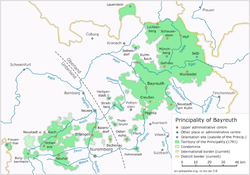Brandenburg-Bayreuth
| Principality of Bayreuth/ Margraviate of Brandenburg-Kulmbach |
||||||||||
| Fürstentum Bayreuth/ Markgraftum Brandenburg-Kulmbach |
||||||||||
| State of the Holy Roman Empire | ||||||||||
|
||||||||||
|
Principality of Brandenburg-Bayreuth as at 1791, when it was sold to Prussia
|
||||||||||
| Capital |
Kulmbach until 1604, Bayreuth from 1604 |
|||||||||
| Government | Principality | |||||||||
| Margrave | ||||||||||
| • | 1398–1420 (first) | John III, Burgrave of Nuremberg | ||||||||
| • | 1769–91 (last) | Christian Frederick, Margrave of Brandenburg-Ansbach |
||||||||
| Historical era | Middle Ages | |||||||||
| • | Partitioned from Burgraviate of Nuremberg | 21 January 1398 1398 |
||||||||
| • | Reunited with Ansbach | 1420–40 | ||||||||
| • | Joined Franconian Circle | 1500 | ||||||||
| • | Partitioned in twain | 1655–1726 | ||||||||
| • | Line extinct; inherited by Ansbach | 20 January 1769 |
||||||||
| • | Ansbach and Bayreuth sold to Prussia | 2 December 1791 1791 |
||||||||
|
||||||||||
The Principality of Bayreuth (German: Fürstentum Bayreuth) or Margraviate of Brandenburg-Bayreuth (Markgraftum Brandenburg-Bayreuth) was an immediate territory of the Holy Roman Empire, ruled by a Franconian branch of the Hohenzollern dynasty. Since Burgrave Frederick VI of Nuremberg was enfeoffed with the Margraviate of Brandenburg in 1415/17, the Hohenzollern princes transferred the margravial title to their Franconian possessions, though the principality never had been a march. Until 1604 they used Plassenburg Castle in Kulmbach as their residence, hence their territory was officially called the Principality of Kulmbach or Margraviate of Brandenburg-Kulmbach until the Empire's dissolution in 1806.
The Kulmbach-Bayreuth principality arose from the northern uplands (Oberland) of the former Burgraviate of Nuremberg, while the southern lowlands (Unterland) formed the Principality of Ansbach. The final border demarcation was settled by the 1541 House Treaty of Regensburg, adding some smaller Unterland territories to Bayreuth, however not connected with the Oberland core territory stretching up to the Franconian Forest and the Fichtel Mountains. Mountainous and densely wooded, most of the lands were of less agricultural use, nevertheless mineral resources, predominantly ore deposits led to the construction of numerous mines.
...
Wikipedia


